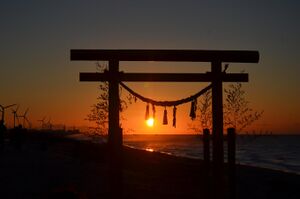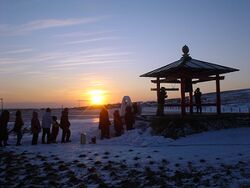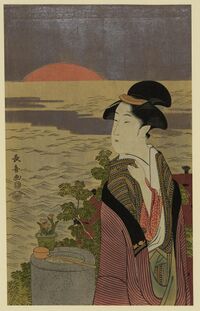Astronomy:First sunrise

The First sunrise refers to the custom of observing the first sunrise of the year. Such a custom may be just an observation of the sunrise on a special day, just for fun, or has a religious meaning for those who worship the Sun, such as the Shintoist followers in Korea, Japan and the Inuit, Yupik, Aleut, Chukchi and the Iñupiat in the Arctic Circle, for praying for good luck.
Japan
In Japan, the observation of the first sunrise of the year (Japanese: 初日の出, romanized: Hatsu-Hinode) on the first day on the Old Calendar has been part of the traditional Shintoist worship of Amaterasu, the sun goddess.[1] Nowadays, Japanese travel agents arrange trips to observe the earliest first sunrise of the year on the new Gregorian calendar in the easternmost Ogasawara Islands of the Japanese archipelago.
Mongolia
In Mongolia, there is a custom of observing the first sunrise on the first day of the year at the top of the mountain the Mongolian lunisolar calendar. commonly known as Tsagaan Sar. The holiday has shamanistic influences.[2][3]
Korea
In Korea, there is also a custom of observing the first sunrise on the first day of the year, either on the traditional Korean calendar or the new calendar.[4]
Canada, Greenland, Russia and the United States
In the Arctic circle, the Inuit, Yupik, Aleut, Chukchi and the Iñupiat observe the first sunrise on the first day of the year (Template:Lang-iu) by extinguishing three qulliqs and relighting them to worship both Malina and Igaluk.[5][6]
See also
- Sunrise
- Japanese New Year
- Quviasukvik
- Caroline Island
References
- ↑ Yamauchi, Yuki (29 December 2016). "First sunrise of the year brings luck". https://www.japantimes.co.jp/life/2016/12/29/lifestyle/first-sunrise-year-brings-luck/.
- ↑ "Tsagaan Sar - The Lunar New Year of Mongolia". https://www.selenatravel.com/blog/tsagaan-sar.
- ↑ "Nomads winter: Tsagaan sar - Mongolian Lunar New Year :: www.touristinfocenter.mn". http://www.touristinfocenter.mn/en/cate3_more.aspx?ItemID=60.
- ↑ Wong, Grace (14 December 2014). "First sunrise - Celebrate the new year with the first Sunrise". https://gracingkorea.wordpress.com/2014/12/14/celebrate-the-new-year-with-the-first-sunrise/.
- ↑ "Ancient ceremony marks new dawn in Canada arctic Lamps lighted as sun rises in new Inuit territory". 18 January 1999. https://www.deseret.com/1999/1/18/19423714/ancient-ceremony-marks-new-dawn-in-canada-arctic-br-lamps-lighted-as-sun-rises-in-new-inuit-territor/.
- ↑ "Dawn of a new year". 17 January 2013. https://nunatsiaq.com/stories/article/dawn_of_a_new_year/.
External links
 |




